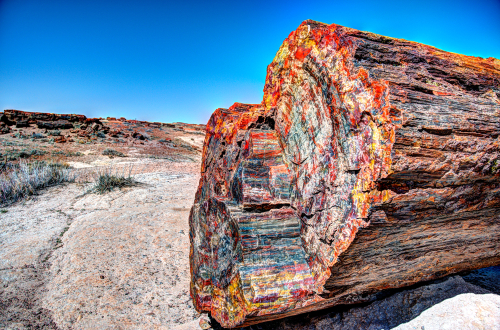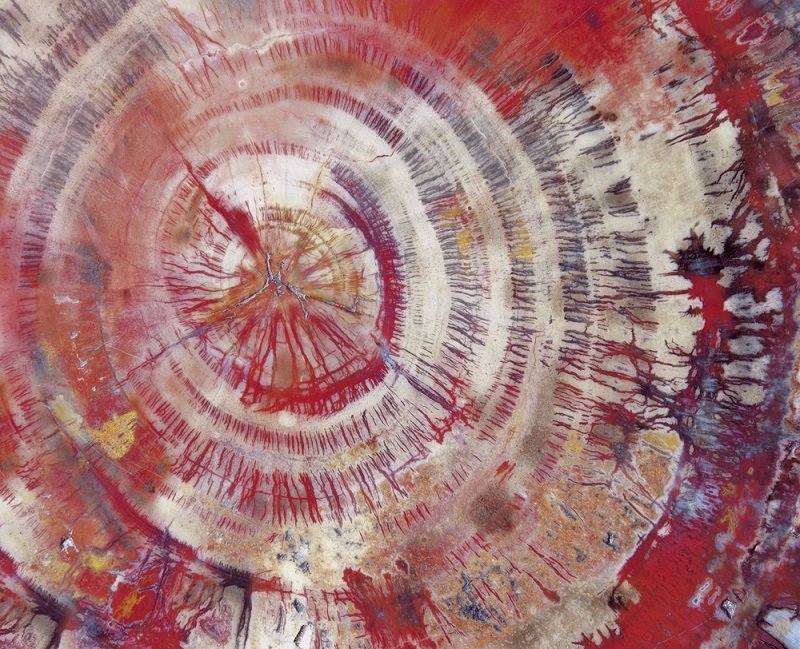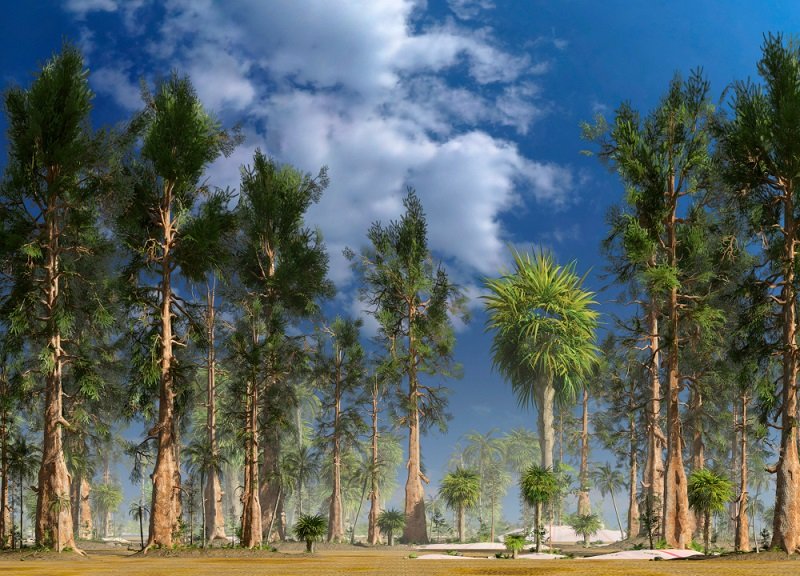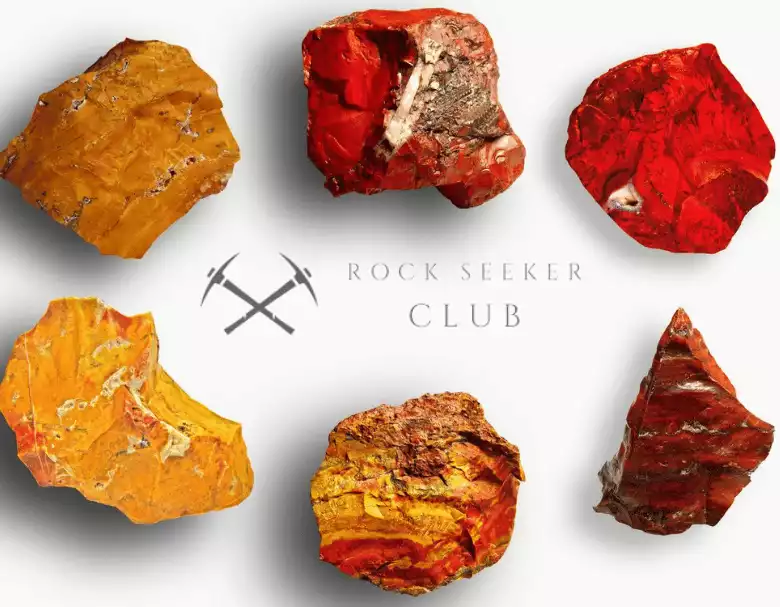Petrified wood is a very unique geological formation. Nature has worked twice here: first by creating a tree and then by turning it into stone. You’re not alone if there’s a lot of questions that pop into your mind thinking about petrified wood. You might be wondering if petrified wood is a plant or stone? Is petrified wood a crystal? Is it a fossil? Why don’t all trees turn into petrified wood? How long does it take to petrify a wood?
That’s exactly why I put this article together, to help answer some of those questions and hopefully many more!
Here’s the main sections we’re going to cover:
- What Is Petrified Wood
- How Long Does It Take For Wood To Petrify?
- Different Types of Petrified Wood
- Interesting Petrified Wood Facts
What Is Petrified Wood?
Is petrified wood a fossil? Yes, petrified wood is a fossil. It is a stone with preserved natural wooden texture. However all of the organic materials of the wood (cellulose and lignin) are no longer present. Instead, those organic materials have been replaced by silica minerals (quartz, chalcedony, agate, opal) and sometimes by calcite, pyrite, or native copper.

Conditions Necessary For Petrified Wood To Form
There are four mandatory conditions that are necessary for petrified wood formation. They are:
1. Absence of Oxygen
The first condition that’s needed for petrified wood to form is the total absence of oxygen. It means that the fossilization or petrification process should occur without access to oxygen. Such a reduction environment exists under the products of volcanic eruptions (volcanic ash) or loose sedimentary mineral material (dune sands, glacial moraine, etc.).
When trees are blown over by volcanic activity, and quickly covered by ash and debris, it quickly deprives the wood from oxygen, beginning the petrification process.
2. Presence of Silica-Rich Liquids
The second condition needed in the formation of petrified wood is the presence of silica-rich fluids, which are soaked up by the wood (now buried under ash, etc) and later crystallize as solid minerals.
Because there is an absence of oxygen, the wood does not deteriorate or decay. And over many, many years, the organic remnants of the wood are gradually replaced by the surrounding minerals.
3. High Pressure
The third condition needed for petrified wood to form is the presence of high pressure. This high pressure environment typically originates from the mass of sediments (ash, mud, sand) that has covered or buried to wood.
Under these high pressure situations, inorganic compounds such as quartz can enter the cells of buried plants little by little. And over time, the organic material is completely replaced by these minerals.
4. Time
The last essential condition is time. In a few million years, the organic compounds of wood will completely disappear and the tree will turn into stone. However, the structure of the trunk and its natural pattern will be completely preserved. You can even distinguish the annual rings! But the age of the material will be distorted a bit for a few million years, plus or minus.
As soon as all the conditions described above are met, the petrified tree is no longer a plant. It contains no organic compounds anymore. The composition is 100% inorganic.
Read More: How Old Is Petrified Wood
The Different Colors of Petrified Wood

The petrified wood is highly praised for its wide range of colors and intriguing texture. The main colors you’ll find are brown, grey, and red. Sometimes you’ll be fortunate enough to find petrified wood with blue, yellow, and green hues that appear due to the presence of different mineral inclusions.
The brightest colors are obtained when metals such as copper, chromium, cobalt, iron, and manganese enter the petrified wood’s structure (Source).
- Copper, depending on the oxidation state, produces colors ranging from green to blue.
- Chromium and cobalt presence can also turn the material into blue or green, but slightly different hues.
- Iron, in the form of oxides (Fe2O3 or Fe2O4), produces all shades of brown from light yellow to almost black.
- Manganese makes petrified wood pink or even orange, while manganese oxides trigger dark shades up to uniform black.
- Residuals of organic compounds provide some carbon, which is responsible for all shades of gray and black.
Metal impurities, which influence the petrified wood color (Source).
How Long Does It Take For Wood To Petrify Naturally?
Petrified wood comes from different Geological Eras. The youngest is from the Pleistocene. We are now living in the Holocene Epoch, which began about 120,000 years ago. Most of the petrified wood has come to us from the Paleozoic and Mesozoic Eras. That means they are 66 million to 500 million year old “dinosaurs”.

Theoretically, a tree can turn to stone in 100 years or even less. But such samples will not have the required hardness that you’ll find in older samples of petrified wood. They can be easily destroyed with slight pressure and are not suitable for decorative element production. Accordingly, the older the petrified wood is, the more it is valued.
In most cases, petrified wood is fossilized remains of trees that grew in the Permian (285-250 million years ago) and Carboniferous (360-299 million years ago) periods (Paleozoic Era). For a better understanding of mentioned numbers, it’s approximately 3 million generations of people or, in other words, 3 million of grand prepositions before grandmother!
The trees and sometimes the whole forests of the previous Geological Eras got buried under the sediments without an oxygen supply. The result is the formation of petrified wood we can observe.
Most Common Species Of Petrified Wood
Geologists find fossilized spruces, coniferous trees, tree ferns, gingkos, pines, araucaria, oaks, birches, alder, elms, laurels, and many other plants. It is known that conifers trees petrify easier than deciduous ones.
The most probable explanation is high antiseptic-resins concentration. That’s why conifers trees are less susceptible to decay. Another explanation is that the conifers wood is silica-reach.
Different Types of Petrified Wood
There is no strict classification of petrified wood. In the past there were some attempts to make a classification based on the type of plant. Unfortunately, not all the samples of petrified wood hold the features of the initial plant.
Petrified wood can be subdivided according to its color described above.
The mineral composition of petrified wood can make up the base for the second classification. Petrified wood can be composed of:
- Quartz – the most abundant mineral at Earth’s surface composed of SiO2 .
- Chalcedony – a cryptocrystalline variety of quartz. Cryptocrystalline means no crystal grains are possible to observe with the naked eye.
- Agate – a variety of chalcedony, but unlike chalcedony, it displays layered texture.
- Opal – a mineraloid. It has the same chemical composition as quartz, but a different crystal structure. Opal displays the opalescence effect that could be described as color flashes inside the stone.
5 types of petrified wood based on structure and texture:
1. Homogeneous Type
The homogeneous type is the simplest one and shows the uniform ring color. This type of petrified wood is usually light-colored and composed mostly of opal.
2. Spotted Type
Spotted type is a highly decorative one. This structure is a combination of opal and chalcedony.
3. Jet-like petrified wood
This type of petrified wood displays clear lines, sometimes forming wavy patterns.
4. Concentric Texture
The concentric texture of petrified wood is characterized by various color layers. The bands are saturated by different minerals resulting in different colors. Opal and chalcedony layers change each other several times to develop a concentric texture.
5. Lens-shaped or Peanut Texture
Lens-shaped or “peanut wood” type of petrified wood is formed by filling the existing cavities of wood (holes bored by actual clams) with other materials (opal, chalcedony, or iron hydroxide). As a result, an intriguing black and white pattern of petrified wood develops.
Interesting Petrified Wood Facts!
1. The first and the most important fact is that petrified wood cannot be used as firewood! No matter what it looks like, petrified wood is not a tree anymore. Despite its appearance, it is in fact a stone!
2. Petrified wood can be found in giant sizes (up to several meters). It’s actually pretty to hear about land owners who dig up entire tree trunks, or even entire petrified trees! In this case, petrified wood, the same way as normal wood, can be used for furniture or interior construction. Of course, the tabletop will be much heavier and much more expensive.
3. Petrified wood is very hard. Its hardness can be explained by its silica composition. It rates between 7 and 8 on Mohs Hardness Scale, because of quartz, which happens to be the main constituent of the petrified wood, which rates 7 on the same scale. For comparison, talc rates at 1 and diamond (the hardest natural material) at 10 on the Mohs hardness scale.
4. Petrified wood is not such a rare material as sapphire or diamond. It is widespread all over the world, however the quality of material that can be found differs from location to location.
5. The most famous petrified forest (petrified forest in Holbrook) is located in the northeast part of Arizona State (USA). Huge placers of the best quality petrified wood were discovered at the end of the 19th century. Since 1906 this area has been declared a Petrified Forest National Park. The samples from Arizona display some of the best colors and patterns found in petrified wood. Fragments of petrified wood, replaced by fine-crystalline quartz, occur in Triassic conglomerates. The fossilized trunks of araucaria are devoid of branches and twigs completely. The largest of them reach 65 meters in length and 3 meters in diameter!
6. Less significant locations of large petrified wood deposits are also found in other countries such as India, Iraq, Syria, Greece (Lesbos Island), Georgia (the Goderdz deposits), Armenia (Sariar deposit), Ukraine (Lvovskoe deposit), Kazakhstan (Tuzkul and Chabakty deposit), and Russia (the Volga region, Central Siberia, Kamchatka, Chukotka and Primorsky Territory).
7. According to scientific research, araucaria (a genus of evergreen coniferous trees) is the most common plant for petrified wood formation.
- Online rock and mineral club for collectors of all levels!
- Find community with like-minded rock and mineral enthusiasts.
- Monthly Giveaways!
- Free Access to Entire Digital Library of Products (annual memberships)


